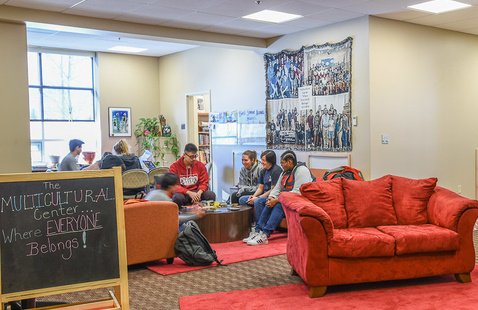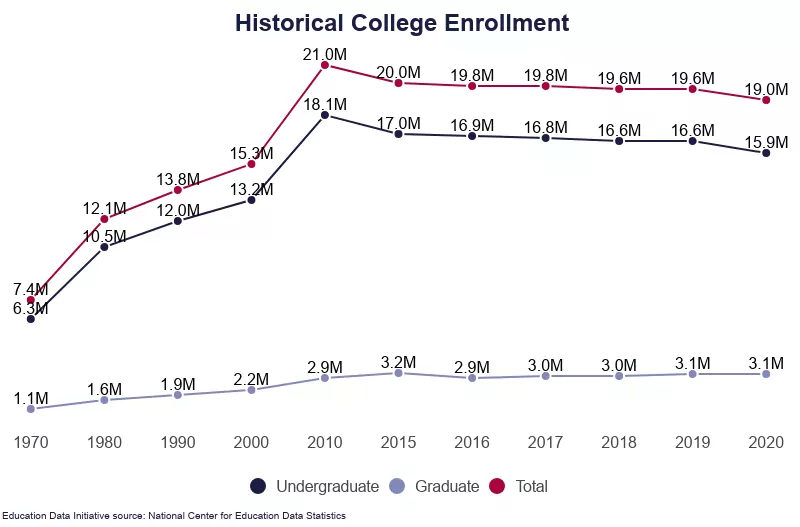
The fundamental nature of college education is changing rapidly — and that transformation extends to the demographics of the students themselves.
Of the more than 19 million students enrolled in collegiate education programs (a number that also encompasses graduate programs) in the U.S., only about 40 percent of them fall into the “traditional” 18-to-20 year old age bracket.
The last decade has seen the number of students enrolled in college decline, down from a high of more than 21 million in 2010. In Colorado, total enrollment across all institutions is down about 2 percent since 2010, even as the state’s population has swelled by more than 600,000 people.
This reversal of a longstanding upward trend in higher education enrollment is not universal in nature. College attendance among Hispanic and Latino populations is up 48 percent since 2010, with more than 80 percent of Hispanic students opting to attend public institutions.
Nearly 20 percent of all college students now identify as Hispanic or Latino in 2022. Enrollment among Asian American students is also up — by more than 20 percent since 2010. Over that same timeframe, White and Black student populations have declined.

Examining these numbers, it is clear that enticing Hispanic and Asian students to attend Western will be crucial to ensuring a strong future for the institution. Continued investments in the Multicultural Center (MCC) — which hosts events from different global cultures, and provides a welcoming environment for all students — can go a long way.
Additionally, Western should look to hire on staff and faculty that foster diversity in the classroom, and across campus more broadly. This can and should include Residence Directors and Residence Life staff, but also professors across the school’s departments — and other staff, particularly those in student support roles.
However, it’s also important to acknowledge that Western will be fighting an uphill battle to attract a diverse pool of students to a small town on the western slope where more than 85 percent of the population identifies as White.
If Western is to grow its share of diverse students, change must come from the top. Appointing first-generation college student Brad Baca, who is Hispanic, to become Western’s 15th president is a great step. The university’s hire for the vice president of diversity and inclusivity — with a search process slated to restart this fall, is also crucial.
Now more than ever, Western needs leaders who recognize the importance of diversity at all levels — in the cabinet, on the Board of Trustees, among faculty and staff, and within the student population — and who go beyond platitudes and semantics to enact real change and create a welcoming, supportive environment that boosts student retention.
Prospective students browsing College Factual, a higher education research platform, will see that Western comes in “below average” on overall diversity, racial and ethnic diversity, and male/female diversity.
Seeing that written out in black and write unlikely to inspire confidence in students making their enrollment decisions. Neither is the fact that the school’s 11.7 percent Hispanic student populace lags behind the nationwide average — part of a larger trend here in Colorado.
Approximately 22 percent of the state’s population is Hispanic, including 32 percent of the K-12 population — but attracting and retaining Hispanic students to Colorado colleges has been an issue across the state.
The four year graduation rate among non-Hispanic White students is 57 percent, but the rate among Hispanic populations sits at just 42 percent.
Now — pushed by larger demographic trends, financial realities, and a desire to become a more diverse institution — Western has an opportunity to improve its proverbial game, and to reap the multipronged benefits of diversity (enhanced student experience and cultural exchange foremost among them) while doing so.
Going beyond race and ethnicity, Western can capitalize on shifting educational trends by tapping into other historically underserved and overlooked demographics in the higher education landscape — older, working individuals being one of them.
Western has already made strides to expand its demographic reach, launching an adult degree completion program that allows individuals who have completed some college to finish their degrees online.
Initiatives like this will be needed to remain competitive in an increasingly tough higher education landscape — where institutions compete for both public and private investment.
Critical to Western’s future will be balancing new programs — like adult completion — with Western’s historic character as a four-year, largely residential college. Doing so will not be easy, but is necessary in an age of declining enrollment and tough choices.
How President Baca and his cabinet go about striking that balance — and approaching the critical role of diversity in campus and academic life — will have enormous ramifications on Western for years to come.
